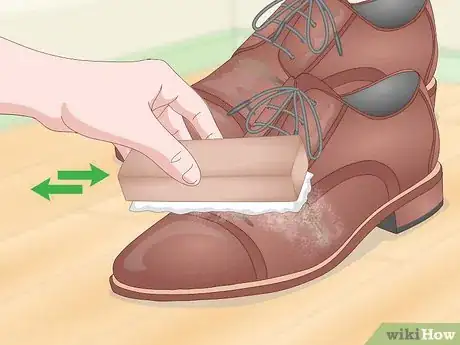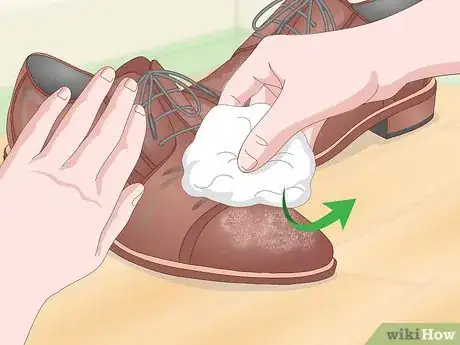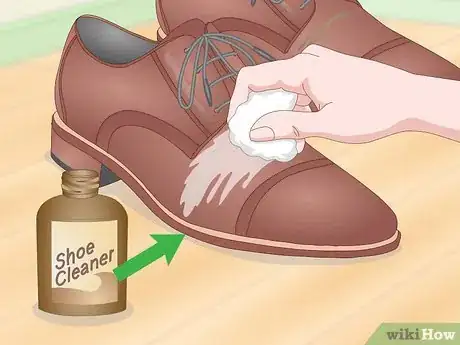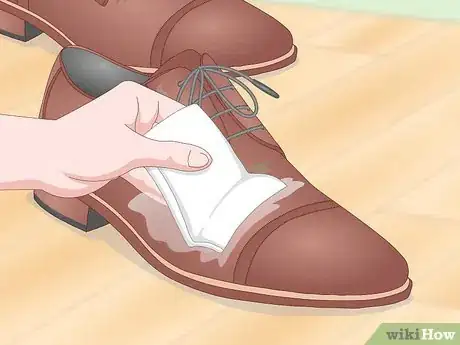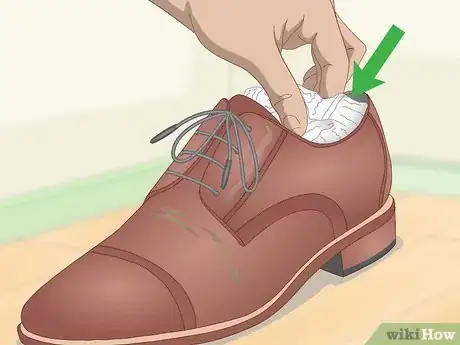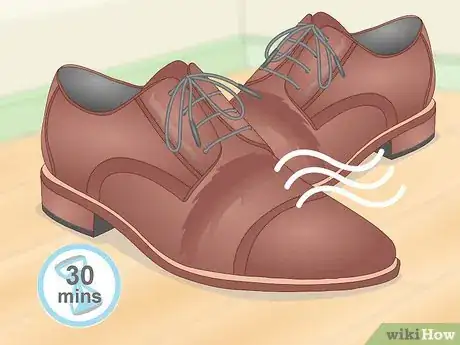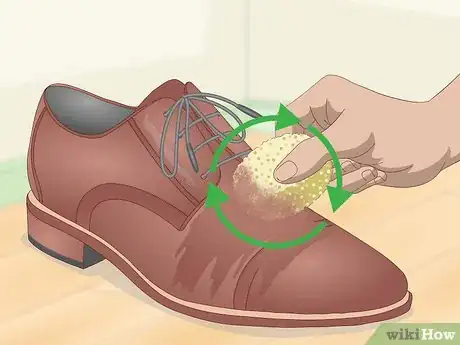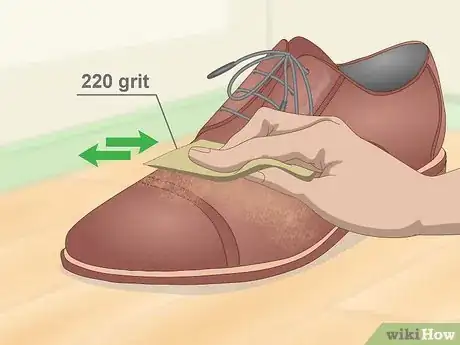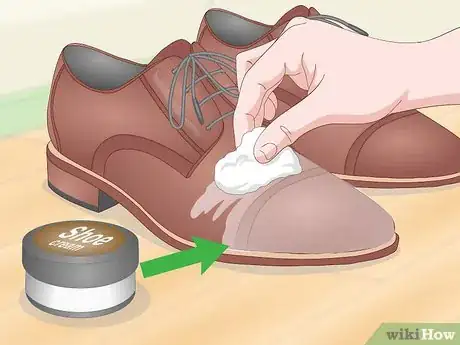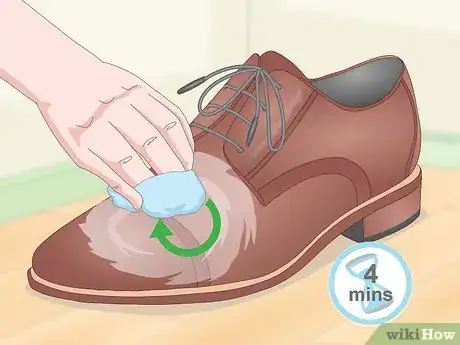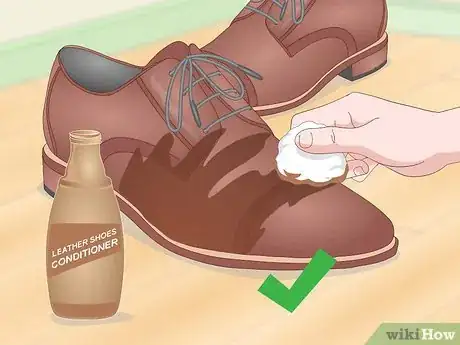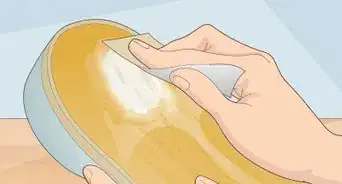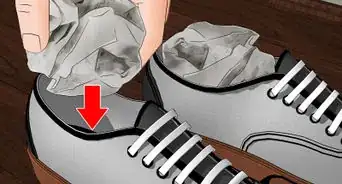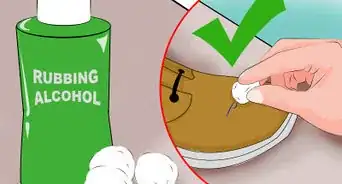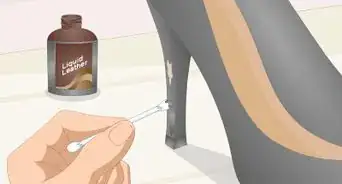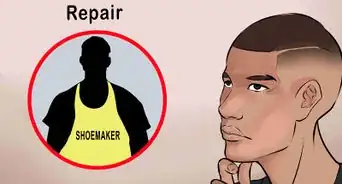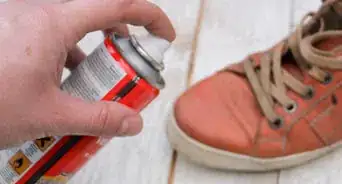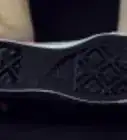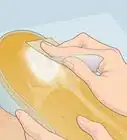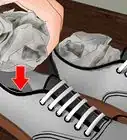This article was co-authored by Penny Simmons. Penny Simmons is a Shoe Care Specialist and the Founder of Penny Loafers Shoe Shine Company Inc. in Toronto, Canada. With over 25 years of experience, Penny specializes in shoe cleaning and shining. Penny offers shoe shining at special events, kiosks in Toronto’s underground city, The PATH, and drop-off services. Penny Loafers Shoe Shine Company also operates the oldest shoeshine parlor in Canada. Penny Loafers Shoe Shine Company has been featured in Best of The City - Toronto Life, Saturday Night Magazine, National Post, Globe & Mail, and Toronto Star.
There are 10 references cited in this article, which can be found at the bottom of the page.
This article has been viewed 135,073 times.
When leather shoes dry out, cracks begin to form. These cracks aren’t technically fixable because the damage can’t be reversed, but you can recondition the leather. Before attempting to treat a crack, clean the shoes to remove as much debris as possible from them. Then, use a leather filler to help hide the cracks. Take advantage of leather conditioners and other products to keep your shoes moisturized. With proper care, you can successfully blend in cracks and prevent new ones from forming.
Steps
Cleaning the Shoes
-
1Brush off any mold or mildew you see on the shoes. Any green spots you notice on the shoes are bound to get in the way of your repairs. Take the shoes outside first to prevent the mold or mildew spores from getting into your home. Then, scrub the spots with a soft-bristled brush or a dry cloth. Dampen the brush or towel in a little bit of warm water if you’re having a hard time clearing off the green spots.[1]
- Consider throwing away the brush or towel after using it to avoid spreading mold spores. A great tool to use for scrubbing is an old toothbrush. You can dispose of it when you’re done.
- Check the storage area for mold and mildew as well. Many times, the spores grow in warm or damp storage areas. Dilute bleach in water to neutralize the spores.
-
2Wipe off as much grime as possible with a damp cloth or brush. Use a cotton cloth, microfiber cloth, or a decent scrub brush. Dampen your scrubber very lightly in warm water. Then, wipe the entire shoe from top to bottom, removing as much visible grime as possible. Repeat this with the other shoe to lightly clean it and moisten it.[2]
- Make sure the cloth or brush isn’t dripping wet. Leather isn’t meant to be soaked in water. A light coating doesn’t harm it and also helps the cleaner you use next.
Advertisement -
3Spread a leather cleaner evenly over both shoes. Saddle soap is a common choice for restoring damaged leather, but there are many alternative cleaners available. Dip a shoe dauber or a cotton cloth into the soap, then scrub the shoes in a circular motion. Watch for the leather to lighten in color as the lather draws out dirt and moisture. Scrub the shoes until the leather feels dry and flexible.[3]
- Lye is harsh on leather shoes, so avoid cleaners with heavy amounts of lye. Instead, make your own or get a product specifically designed for shoes.
- Any leather treatment product you need, including soap, is available online. Also, check at your nearest general, home improvement store, or any place that specializes in leather goods.
- Another option is to buy a leather maintenance kit. A good kit contains almost everything you need, including a cleaner, conditioner, filler, and applicators.
-
4Wipe the leather dry with a clean cloth. Use another cotton or microfiber cloth to remove the dirt, cleaner, and water right away. Buff the leather in a circular motion until you have scrubbed the entirety of both shoes. Pay particular attention to the cracks. Scrub those areas with a little extra strength to ensure you get any dirt hiding in the cracks.[4]
- Another option is to leave the cleaner to dry overnight. This is safe to do with saddle soap, but check the manufacturer’s recommendations for other products. If your shoes are still dirty or you plan on working on them right away, dry them off by hand instead.
Repairing Cracks
-
1Stuff newspaper or rags into the shoes to hold their shape. Crumple the newspaper into balls or roll the rags up. Fill the shoes completely, leaving as little empty space inside as possible. Stuffing the shoes maintains their form while you work on them. The newspaper or towels also absorb any moisture that leaks inside.
- Consider also stuffing the shoes when you’re not using them, particularly if you put them in storage.
-
2Apply mink oil or another moisturizer to rehydrate the leather. Mink oil is solid, so you don’t really need anything other than your fingers to apply it. Most other moisturizers are liquid and have to be applied with an applicator brush or cotton cloth. Spread the moisturizer onto the cracks first. Push the moisturizer down into the cracks to rehydrate them and make them less severe.[5]
- Heating the leather slightly, such as with a space heater or hair dryer, helps it absorb the oil.
- Cleaning leather with soap dries it out, so take the time to rehydrate both shoes now. Focus on the cracks, but don’t neglect other areas.
- Mink oil is a good match for leather, but some people find that bottled moisturizers last longer and offer more protection. These products are often made with beeswax and other natural oils. Purchase moisturizer online, at a general store, or at a clothing store that carries leather products.
-
3Apply a leather filler with a sponge to fill in most cracks. Most leather fillers are water-based acrylics that blend in medium to deep cracks. Use the sponge to dab the compound into the crack. For massive cracks you can’t quite fill with a sponge alone, try using a plastic palette knife. Fill the crack until the material is even with the surface of the leather.[6]
- Keep in mind that you can’t exactly “fix” leather. Cracks are permanent because the fibers in leather pull apart. The best you can do is fill noticeable cracks to hide them.
-
4Let the leather dry for at least 30 minutes. The drying time varies depending on the moisturizer you used and how much filler you had to apply. For the best result, wait for the leather to completely dry, which takes no longer than 24 hours. Deep cracks with filler generally take about 30 minutes to solidify.[7]
- Consult the manufacturer’s instructions on the product you use for the recommended drying time. At the very least, wait for the filler material to solidify before adding more of it.
-
5Use more filler as needed to finish filling in the cracks. Check each crack to see how well it blends in with the leather around it. If it is still noticeable, go back over it again. Add more of the filler material to level out the crack. When you’re done, wait again for the filler to dry before continuing.
-
6Buff the filler smooth with 220-grit sandpaper. Press the sandpaper against the treated areas with light but steady pressure. Scrub the cracks until they blend in completely with the surrounding leather. When everything looks good, wipe your shoes off again with a dry rag to remove any dust.[8]
- Use only fine-grit sandpaper. Using anything coarser can add new scratches to your shoes.
Coloring and Moisturizing Shoes
-
1Use a shoe cream if your shoes look discolored. Polish the leather by applying the cream over the filler with a shoe dauber or cotton cloth. Work the cream into the leather in a circular motion. Shoe creams polish and add color to leather, so make sure you choose a color you don’t mind wearing. Try to select a cream that matches the color of your shoes.[9]
- Creams work very well on repaired cracks, but you can also use them to color the rest of the leather.
-
2Buff the shoes with a clean cotton cloth for 4 minutes. Use a cotton or microfiber cloth to restore the leather back to its normal state. Starting at the top of each shoe, rub the leather with small, circular motions. Buff both shoes equally to get them to look the same. Make sure you treat all parts of the shoe the same way so the leather looks uniform all over.[10]
- Check the shoes again to see how they look. With proper treatment, the cracks will no longer be visible. Use more filler, cream, or other products as needed.
-
3Treat your shoes with a leather conditioner once a week. A great time to start conditioning is after you finish with the repairs. Use a clean cotton or microfiber cloth to avoid working dirt into the leather. Apply the conditioner in a thin, even layer by buffing the leather with small, circular motions. Work on one part of the shoe at a time until you have it completely covered.[11]
- As an animal material, leather needs regular oiling to prevent it from drying out and cracking. Regular conditioning also masks old cracks and prevents them from reappearing.
Expert Q&A
Did you know you can get expert answers for this article?
Unlock expert answers by supporting wikiHow
-
QuestionHow do you prevent cracks in leather shoes?
 Penny SimmonsPenny Simmons is a Shoe Care Specialist and the Founder of Penny Loafers Shoe Shine Company Inc. in Toronto, Canada. With over 25 years of experience, Penny specializes in shoe cleaning and shining. Penny offers shoe shining at special events, kiosks in Toronto’s underground city, The PATH, and drop-off services. Penny Loafers Shoe Shine Company also operates the oldest shoeshine parlor in Canada. Penny Loafers Shoe Shine Company has been featured in Best of The City - Toronto Life, Saturday Night Magazine, National Post, Globe & Mail, and Toronto Star.
Penny SimmonsPenny Simmons is a Shoe Care Specialist and the Founder of Penny Loafers Shoe Shine Company Inc. in Toronto, Canada. With over 25 years of experience, Penny specializes in shoe cleaning and shining. Penny offers shoe shining at special events, kiosks in Toronto’s underground city, The PATH, and drop-off services. Penny Loafers Shoe Shine Company also operates the oldest shoeshine parlor in Canada. Penny Loafers Shoe Shine Company has been featured in Best of The City - Toronto Life, Saturday Night Magazine, National Post, Globe & Mail, and Toronto Star.
Shoe Care Specialist
Warnings
- Leather oils and creams may change the color of your shoes. Use these products sparingly to avoid unwanted color changes.⧼thumbs_response⧽
Things You’ll Need
- Shoe dauber or brush
- Cotton or microfiber cloths
- Saddle soap or alternative leather soap
- Mink oil or alternative leather moisturizer
- Leather conditioner
- Palette knife for deep cracks
- Water
- Shoe cream for recoloring
References
- ↑ https://www.canada.ca/en/conservation-institute/services/conservation-preservation-publications/canadian-conservation-institute-notes/removing-mould-leather.html
- ↑ https://tips.simplygoodstuff.com/how-to-clean-leather/
- ↑ https://www.youtube.com/watch?v=fTAHYTh5Osg&feature=youtu.be&t=17
- ↑ https://www.youtube.com/watch?v=fTAHYTh5Osg&feature=youtu.be&t=36
- ↑ https://homequicks.com/mink-oil-for-leather
- ↑ https://www.youtube.com/watch?v=k7CoEgzoJlI&feature=youtu.be&t=83
- ↑ https://homequicks.com/mink-oil-for-leather
- ↑ https://www.youtube.com/watch?v=DaefzAWd65I&feature=youtu.be&t=561
- ↑ https://www.youtube.com/watch?v=IvBwlyiKa7g&feature=youtu.be&t=16
About This Article
While you can’t actually get rid of cracks in leather shoes, reconditioning the leather and covering the cracks with a filler will minimize their appearance. Wipe off as much surface grime as you can with a damp cloth, then scrub your shoes with a soft cloth dipped in leather cleaner. Wipe the shoes dry with a clean, dry cloth when you’re done. Stuff rags or wads of newspaper into the shoes to help them keep their shape, then moisturize the leather by wiping it down with mink oil. Focus on the cracks and other areas that are especially dried out. Next, dip a sponge in leather filler and dab it into the cracks to fill them in and hide them. Let the filler dry for at least 30 minutes, then apply another layer if the cracks are still visible. Once the filler is completely dry, lightly buff it smooth with 220-grit sandpaper. Wipe your shoes again with a dry rag to remove the dust.
